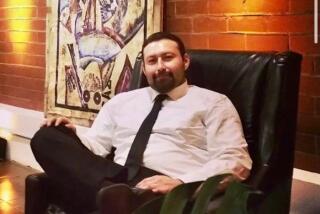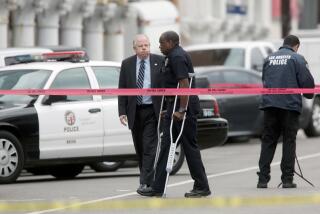Days before suit against officer, he is charged
On an April afternoon in 2005, Oscar Mendez and Frank Carrillo decided to ease their boredom by driving to Anaheim and buying some pot. But when they pulled into an alley to make a deal, things quickly went south.
A police officer spotted them, a brief car chase ensued and, in the end, the patrolman opened fire, killing Carrillo and wounding Mendez in the hip.
Mendez, who was already using a wheelchair as a result of a gang shooting years earlier, sued the officer, alleging excessive force. Now, nearly two years after the shooting and just five days before his case was to go to trial, Mendez has been charged in the shooting.
For Mendez, a 27-year-old from Orange who admits he has had his share of run-ins with the law, it could mean life in prison.
His attorney, John E. Sweeney, said the timing of the felony charges was suspicious and appeared to be an attempt by the Orange County district attorney’s office “to help their friends in Anaheim.”
But Deputy Dist. Atty. Troy Pino said the timing was coincidental. He blamed the delay in filing charges on the unavailability of a Santa Ana police gang expert and a change in prosecutors.
Pino said the key to the charges against Mendez was DNA found on a handgun recovered at the scene. The DNA was not detected until three months after the shooting, prosecutors said. Sweeney said he was told that Mendez’s skin cells were found on the gun’s handle.
Even though Mendez is a potential three-striker and an alleged gang member, authorities let him remain free without bail for 20 months. His arraignment on Friday was postponed for a month. Pino asked that Mendez be held on $1-million bail, but Superior Court Judge Roger B. Robbins released him on his own recognizance.
Earlier, the prosecutor said he was not especially worried that Mendez would flee, despite the sentence he may face. “It’s not a concern, and I don’t think he’s an imminent danger to anyone,” Pino said. “We have to balance the protection of the community with fairness to the defendant.”
Mendez said he also found it strange that his attorney was notified of the felony charges by the Anaheim city attorney, and that he never heard directly from the district attorney’s office. Pino contends his office mailed a letter explaining the charges to Mendez.
He has been charged with possession of a firearm by a felon, being a gang member carrying a loaded firearm in public, receipt of stolen property and engaging in street terrorism. Prosecutors said he was engaging in criminal street gang activity at the time of the incident.
Robert Wilson, a Pasadena lawyer and spokesman for California Attorneys for Criminal Justice, the state’s largest organization of criminal defense lawyers, was astonished that a potential third-strike case was handled this way. “This is unbelievable,” he said. “You never see an arraignment letter sent on a gang enhancement felony.”
Pino said Mendez’s alleged membership in a Santa Ana gang is a crucial part of the case. Because Anaheim police were not familiar with the gang, Pino said, the district attorney’s office needed help from a Santa Ana police gang investigator.
Santa Ana gang detectives were tied up on local investigations for months, and unable to assist in the case until three weeks ago, Pino said.
Pino said he contacted Santa Ana police when he began working the case in earnest in September. “They didn’t respond for quite a while,” he said. “The day before I filed the case, a gang detective contacted me and became my expert,” he said.
But a Santa Ana police spokesman said the department received the request for assistance more recently than that. “To the best of our knowledge, a request for a gang expert was made by the district attorney’s office in the last two months,” said Sgt. Lorenzo Carrillo, who is not related to Frank Carrillo, the man fatally shot.
Mendez admits he has not been a model citizen. Before he was paralyzed in a gang shooting at 18, Mendez said, he had been jailed for grand theft auto, carrying a pistol and brandishing a firearm. He had known Carrillo most of his life. “We’re stoners together,” Mendez said an October 2005 interview with The Times.
On that April day, he and Carrillo were sitting in Mendez’s Orange apartment, bored and watching TV. They decided to buy some pot. Carrillo lifted Mendez into the passenger seat of his Chevy S-10 truck and tossed Mendez’s wheelchair in the back. They drove to an alley in an Anaheim neighborhood that rubs alongside La Palma Avenue, not far from where the Santa Ana and Riverside freeways intersect. They were met by a dealer.
Mendez’s version and the police account of what happened are similar, though certainly not identical. He admitted that after seeing a police cruiser turn into the alley, Carrillo threw the truck into reverse and ignored commands to stop, driving backward.
He said they were afraid the police officer, Eddie Ruiz, was going to shoot them, because he drew his pistol as he walked toward them. But Mendez said Carrillo never attempted to run over Ruiz, as alleged by authorities.
Police say Ruiz feared for his life and fired three shots. Ruiz’s partner, James Cossin, who was standing near the police car, never fired his weapon.
The police report said neither Carrillo nor Mendez fired, and the officers did not see either of them with a gun. Nevertheless, police said they found a gun in the bushes, close to the driver’s door. Mendez said neither he nor Carrillo were armed.
Pino said forensic tests done in July 2005, three months after the shooting, found Mendez’s DNA on the gun, but not his fingerprints.
At Friday’s court hearing, Sweeney accused the officers of planting the gun. “Our theory and position is that it’s a drop gun,” he said.
An Anaheim police spokesman said Ruiz, who was cleared in a routine investigation of the shooting by the district attorney’s office, declined to comment.
Ruiz is also a defendant in a federal lawsuit stemming from an unrelated incident that occurred six weeks after he shot Mendez and Carrillo; that case is in mediation. In that incident, according to court records, Ruiz drove his patrol car at 35 mph on a sidewalk, striking a 20-year-old parolee who was allegedly in the process of surrendering to police. The man, who was trapped under the car and dragged a short distance, was seriously injured. Ruiz said he did not intend to hit him.
Mendez said he was shaken by the new charges, which he called “bogus.” He said he was enrolled in an adult public education program to learn how to process mortgage loans and planned to take real estate classes.
“I’m trying to keep my mind busy,” he said. “But it seems I’m being punished for the mistakes I made when I was younger. “
*
More to Read
Sign up for Essential California
The most important California stories and recommendations in your inbox every morning.
You may occasionally receive promotional content from the Los Angeles Times.









